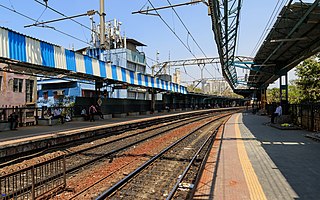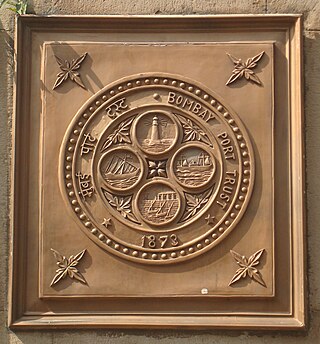
A harbor, harbour, or haven is a sheltered body of water where ships, boats, and barges can be docked. The term harbor is often used interchangeably with port, which is a man-made facility built for loading and unloading vessels and dropping off and picking up passengers. Ports usually include one or more harbors. Alexandria Port in Egypt is an example of a port with two harbors.

The Bombay explosion occurred on 14 April 1944, in the Victoria Dock of Bombay, British India when the British freighter SS Fort Stikine, carrying a mixed cargo of cotton bales, timber, oil, gold, and ammunition including around 1,400 tons of explosives with an additional 240 tons of torpedoes and weapons, caught fire and was destroyed in two giant blasts, scattering debris, sinking surrounding ships and setting fire to the area, killing around 800 to 1,300 people. Some 80,000 people were made homeless and 71 firemen lost their lives in the aftermath.

The Gateway of India is an arch-monument built in the early 20th century in the city of Mumbai (Bombay), India. It was erected to commemorate the landing of King-Emperor George V, the first British monarch to visit India, in December 1911 at Strand Road near Wellington Fountain.

Colaba is a part of the city of Mumbai, India. It is one of the four peninsulas of Mumbai while the other three are Worli, Bandra and Malabar Hill. During Portuguese rule in the 16th century, the island was known as Kolbhat. After the British took over the island in the late 17th century, it was known as Kolio.

Cotton Green is a suburb of Mumbai, and a noted residential and commercial area east of Parel, in central Mumbai, 8 km north of Colaba. It is also the name of a railway station on the Mumbai suburban railway, which lies along the Harbour line, which is a part of the Central Railway.

Alibag, also known as Alibaug, is a coastal town and a municipal council in Raigad district of Maharashtra, India. It is the headquarters of the Raigad district and is south of the city of Mumbai. Alibag is part of the Mumbai Metropolitan Region and is situated at a distance of about 96 km from Mumbai and 143 km from Pune. Alibag is a holy place for Goddess Shree Padmakshi Renuka, and thousands of people go there to worship every day. she also known as goddess of konkan

The Port of Liverpool is the enclosed 7.5-mile (12.1 km) dock system that runs from Brunswick Dock in Liverpool to Seaforth Dock, Seaforth, on the east side of the River Mersey and the Birkenhead Docks between Birkenhead and Wallasey on the west side of the river. The port was extended in 2016 by the building of an in-river container terminal at Seaforth Dock, named Liverpool2. The terminal can berth two 14,000 container Post-Panamax ships.

The history of Mumbai, can be traced back to 600 BC, when evidences of the first known settlement, Harrappan civilization, here have been discovered.

Elephanta Island is one of a number of islands in Mumbai Harbour, east of Mumbai, India.

David Sassoon was the treasurer of Baghdad between 1817 and 1829. He became the leader of the Jewish community in Mumbai after Baghdadi Jews emigrated there.

Bhaucha Dhakka is a wharf along the Thane Creek, along the coast of Dockyard Road on the Eastern seafront of Mumbai, the capital of the Indian state of Maharashtra. The wharf serves as the port for numerous fishermen who bring in their daily catch. Ferry services link up JNPT, Uran to the east, and Rewas and Mandwa to the south. The wharf is used by the students of the Training Ship Rahaman which is an institute for maritime studies on the island of Nhava.
Rewas(Rewas-Bodani or Revas) is one of 48 “minor” ports of Maharashtra located at Rewas Creek, near Karanja creek at mouth of the Patalganga River about 10 kilometres (6 mi) southward of Jawaharlal Nehru Port (JNPT) and 16 kilometres (9.9 mi) south-east of Mumbai Port. It is controlled by the state government through an agency known as the “Maharashtra Maritime Board”.
Colaba Causeway, officially known as Shahid Bhagat Singh Road, is a commercial street, and a major causeway or land link between Colaba and the Old Woman's Island in the city of Mumbai, India.

Millbay, also known as Millbay Docks, is an area of dockland in Plymouth, Devon, England. It lies south of Union Street, between West Hoe in the east and Stonehouse in the west. The area is currently subject to a public-private regeneration creating new homes, business premises, marina, a 1000-pupil school and opening up the waterfront to greater public access.

Mumbai Port Trust is a port which lies midway on the West coast of India, on the natural deep-water harbour of Mumbai (Bombay) in Maharashtra.The harbour spread over 400 square kilometres (150 sq mi) is protected by the mainland of Konkan to its east and north and by the island city of Mumbai to its west. The harbour opens to the south to the Arabian Sea.

Bombay, also called Bom baim in Portuguese, is the financial and commercial capital of India and one of the most populous cities in the world.
The 1947 Ramdas ship disaster occurred near Bombay in India. The Indian passenger ship SS Ramdas, while bound for Rewas in Maharashtra, capsized on 17 July 1947, near Gull Island, ten miles from Colaba(South Mumbai)Point, killing 724 of the people on board.

Ballar Bunder Gatehouse is a Grade I Heritage structure that has been converted into a maritime museum, located at Ballard Estate in the old Fort area of Mumbai, India. It was built in 1920 to commemorate the realignment of the harbour and is located where Ballard Pier, a small pier once existed with an approach jetty at right angles to the pier. The building was among the five entries from the Mumbai for the 2009 UNESCO Asia-Pacific Heritage Awards for Culture Heritage Conservation. It is one of the stops on Special tour of Museums in the city, a tour organised by BEST and MTDC as well as the Naval Dockyard Heritage Walk, conducted by the Naval Dockyard on the first Sunday of every month.
Bandar or Bunder is a Persian word meaning "port" and "haven". Etymologically it combines Persian بند Band (enclosed) and در dar meaning "an enclosed area" derived from Sanskrit/Avestan Bandha and Dwara (entrance). The word travelled with Persian sailors over a wide area leading to several coastal places in Iran and elsewhere having Bandar (haven) as part of their names. In some Indian languages the word Bandargah means "port". In Indonesian Malay it means "port". In Assamese-Bengali languages "bondor" means port.

Early in 2020, in the early days of the COVID-19 pandemic, the disease spread to a number of cruise ships, with the nature of such ships – including crowded semi-enclosed areas, increased exposure to new environments, and limited medical resources – contributing to the heightened risk and rapid spread of the disease.


















